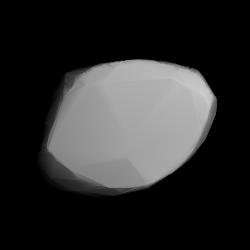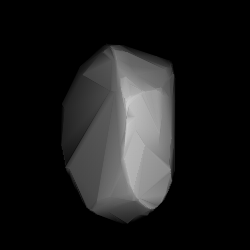Related Research Articles

1743 Schmidt, provisional designation 4109 P-L, is a dark background asteroid from the inner regions of the asteroid belt, approximately 19 kilometers in diameter. It was discovered during the Palomar–Leiden survey on 24 September 1960, by astronomers Ingrid and Cornelis van Houten at Leiden, on photographic plates taken by Tom Gehrels at Palomar Observatory in California. The C-type asteroid has a rotation period of 17.5 hours. It was named for the optician Bernhard Schmidt.
1179 Mally, provisional designation 1931 FD, is an asteroid and long-lost minor planet from the central region of the asteroid belt, approximately 13 kilometers in diameter. Discovered by Max Wolf in 1931, the asteroid was lost until its rediscovery in 1986. The discoverer named it after his daughter-in-law, Mally Wolf.
6433 Enya, provisional designation 1978 WC, is a stony background asteroid from the inner regions of the asteroid belt, approximately 7 kilometers in diameter. It was discovered on 18 November 1978, by Czech astronomer Antonín Mrkos at the Kleť Observatory in the Czech Republic. It was named for Irish musician Enya.
6537 Adamovich, provisional designation 1979 QK6, is a stony Florian asteroid from the inner regions of the asteroid belt, approximately 4 kilometers in diameter.
12848 Agostino, provisional designation 1997 NK10, is a stony Eunomia asteroid from the central region of the asteroid belt, approximately 5 kilometers in diameter.
7385 Aktsynovia, provisional designation 1981 UQ11, is a background asteroid from the inner regions of the asteroid belt, approximately between 4 and 9 kilometers in diameter, depending on its assumed spectral type. It was discovered on 22 October 1981, by Soviet–Russian astronomer Nikolai Chernykh at the Crimean Astrophysical Observatory in Nauchnyj on the Crimean peninsula.
4151 Alanhale, provisional designation 1985 HV1, is a carbonaceous Themistian asteroid from the outer region of the asteroid belt, approximately 19 kilometers in diameter. It was discovered by the American astronomer couple Carolyn and Eugene Shoemaker at the U.S. Palomar Observatory, California, on 24 April 1985. It was named for American astronomer Alan Hale.
17102 Begzhigitova (provisional designation 1999 JB41) is a stony Florian asteroid from the inner regions of the asteroid belt, approximately 3 kilometers in diameter. It was discovered on 10 May 1999, by astronomers of the Lincoln Near-Earth Asteroid Research at the Lincoln Laboratory's Experimental Test Site in Socorro, New Mexico, United States. The asteroid was named after Akmaral Begzhigitova, an ISEF awardee of 2003.
2126 Gerasimovich, provisional designation 1970 QZ, is a stony background asteroid from the inner regions of the asteroid belt, approximately 8 kilometers in diameter. It was discovered on 30 August 1970, by Soviet astronomer Tamara Smirnova at the Crimean Astrophysical Observatory in Nauchnyj, on the Crimean peninsula. The asteroid was named after Russian astronomer Boris Gerasimovich.
2324 Janice, provisional designation 1978 VS4, is a dark background asteroid from the outer regions of the asteroid belt, approximately 25 kilometers (16 miles) in diameter. It was discovered on 7 November 1978, by American astronomers Eleanor Helin and Schelte Bus at the Palomar Observatory in California. The asteroid was named for Janice Cline at Caltech. The presumably C-type asteroid has a rotation period of 23.2 hours.
4944 Kozlovskij, provisional designation 1987 RP3, is a carbonaceous Witt asteroid from the central regions of the asteroid belt, approximately 10 kilometers (6 miles) in diameter. It was discovered on 2 September 1987, by Soviet astronomer Lyudmila Chernykh at the Crimean Astrophysical Observatory in Nauchnij, on the Crimean Peninsula. The asteroid was named for Russian opera singer Ivan Kozlovsky.
3184 Raab, provisional designation 1949 QC, is a dark background asteroid and a potentially slow rotator from the central regions of the asteroid belt, approximately 17 kilometers in diameter. It was discovered on 22 August 1949, by South African astronomer Ernest Leonard Johnson at the Union Observatory in Johannesburg. The likely C-type asteroid could have a long rotation period of 275 hours. It was named after Austrian amateur astronomer and software engineer Herbert Raab.

2111 Tselina is a stony Eos asteroid from the outer regions of the asteroid belt. It was discovered on 13 June 1969, by Soviet astronomer Tamara Smirnova at Crimean Astrophysical Observatory in Nauchnij, on the Crimean peninsula. The S-type asteroid has a rotation period of 6.6 hours and measures approximately 23 kilometers in diameter. It was later named after the Soviet Virgin Lands Campaign.
1323 Tugela, provisional designation 1934 LD, is a dark background asteroid from the outer regions of the asteroid belt, approximately 60 kilometers in diameter. It was discovered on 19 May 1934, by South African astronomer Cyril Jackson at the Union Observatory in Johannesburg. The asteroid was named for the Tugela River in western South Africa.
1684 Iguassú, provisional designation 1951 QE, is a carbonaceous asteroid from the outer region of the asteroid belt, approximately 30.5 kilometers in diameter. It was discovered on 23 August 1951, by Argentine astronomer Miguel Itzigsohn at the La Plata Astronomical Observatory, located in the city of La Plata, Argentina. It was named after the Iguazu Falls in South America.
2011 Veteraniya, provisional designation 1970 QB1, is a stony Vestian asteroid from the inner regions of the asteroid belt, approximately 6 kilometers in diameter. It was discovered on 30 August 1970, by Russian astronomer Tamara Smirnova at the Crimean Astrophysical Observatory, Nauchnyj, on the Crimean peninsula, and named for the Soviet veterans of the Second World War.
6102 Visby, provisional designation 1993 FQ25, is a stony background asteroid from the central region of the asteroid belt, approximately 5 kilometers (3.1 miles) in diameter.
12999 Toruń, provisional designation 1981 QJ2, is a carbonaceous Baptistina asteroid from the inner regions of the asteroid belt, approximately 8 kilometers in diameter. It was discovered on 30 August 1981, by British–American astronomer Edward Bowell at Lowell Observatory's Anderson Mesa Station in Flagstaff, Arizona, and named after the Polish city of Toruń.
40463 Frankkameny, provisional designation 1999 RE44, is a carbonaceous background asteroid from the central region of the asteroid belt, approximately 4 kilometers in diameter. It was discovered on 15 September 1999, by Canadian amateur astronomer Gary Billings at Calgary Observatory (681) in Alberta, Canada. The asteroid was named after American activist Frank Kameny.
14436 Morishita, provisional designation 1992 FC2, is a stony background asteroid and exceptionally slow rotator from the middle region of the asteroid belt, approximately 5 kilometers in diameter.
References
- 1 2 3 4 "JPL Small-Body Database Browser: 17163 Vasifedoseev (1999 LT19)" (2017-03-30 last obs.). Jet Propulsion Laboratory . Retrieved 26 June 2017.
- 1 2 3 Schmadel, Lutz D. (2006). "(17163) Vasifedoseev [2.90, 0.08, 1.3]". Dictionary of Minor Planet Names – (17163) Vasifedoseev, Addendum to Fifth Edition: 2003–2005. Springer Berlin Heidelberg. p. 107. doi:10.1007/978-3-540-34361-5_1132. ISBN 978-3-540-34360-8.
- 1 2 3 4 5 6 "LCDB Data for (17163) Vasifedoseev". Asteroid Lightcurve Database (LCDB). Retrieved 17 May 2016.
- 1 2 3 4 Mainzer, A.; Grav, T.; Masiero, J.; Hand, E.; Bauer, J.; Tholen, D.; et al. (November 2011). "NEOWISE Studies of Spectrophotometrically Classified Asteroids: Preliminary Results". The Astrophysical Journal. 741 (2): 25. arXiv: 1109.6407 . Bibcode:2011ApJ...741...90M. doi:10.1088/0004-637X/741/2/90 . Retrieved 17 May 2016.
- 1 2 3 Masiero, Joseph R.; Mainzer, A. K.; Grav, T.; Bauer, J. M.; Cutri, R. M.; Dailey, J.; et al. (November 2011). "Main Belt Asteroids with WISE/NEOWISE. I. Preliminary Albedos and Diameters". The Astrophysical Journal. 741 (2): 20. arXiv: 1109.4096 . Bibcode:2011ApJ...741...68M. doi:10.1088/0004-637X/741/2/68 . Retrieved 3 December 2016.
- 1 2 3 Waszczak, Adam; Chang, Chan-Kao; Ofek, Eran O.; Laher, Russ; Masci, Frank; Levitan, David; et al. (September 2015). "Asteroid Light Curves from the Palomar Transient Factory Survey: Rotation Periods and Phase Functions from Sparse Photometry". The Astronomical Journal. 150 (3): 35. arXiv: 1504.04041 . Bibcode:2015AJ....150...75W. doi:10.1088/0004-6256/150/3/75 . Retrieved 17 May 2016.
- 1 2 Veres, Peter; Jedicke, Robert; Fitzsimmons, Alan; Denneau, Larry; Granvik, Mikael; Bolin, Bryce; et al. (November 2015). "Absolute magnitudes and slope parameters for 250,000 asteroids observed by Pan-STARRS PS1 - Preliminary results". Icarus. 261: 34–47. arXiv: 1506.00762 . Bibcode:2015Icar..261...34V. doi:10.1016/j.icarus.2015.08.007 . Retrieved 17 May 2016.
- 1 2 "17163 Vasifedoseev (1999 LT19)". Minor Planet Center. Retrieved 25 January 2016.
- ↑ "MPC/MPO/MPS Archive". Minor Planet Center. Retrieved 17 May 2016.